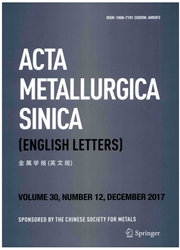

 中文摘要:
中文摘要:
平衡格子常数,有弹性的常数和 wII 尖晶石和尖晶石以后的 Si3N4 的有弹性的 moduli 分别地在 040 GPa 和 160240 GPa 的压力范围被调查了。这二个阶段被发现动态地稳定。尖晶石以后的阶段是还在极端压缩下面调查的最强壮的材料之一。一些基本性质和阶段转变人物从伪泛音近似被评估。到尖晶石以后的阶段的从阶段的转变压力是 152.5 GPa (在 300 K ) 并且 181.8 GPa (在 1500 K ) 。wII 和尖晶石以后的转变的阶段转变压力与温度的上升增加;因此,在更高的温度,综合要求更高的压力尖晶石以后的 Si3N4。热能力,热扩大和新阶段的体积模量作为压力和温度的功能被计算。尖晶石以后的 Si3N4 的热能力在高温度大并且仅仅微弱地迫使依赖者。
 英文摘要:
英文摘要:
The equilibrium lattice constants, elastic constants and elastic moduli of wll- and post-spinel Si3Na have been investigated in the pressure ranges of 0-40 GPa and 160-240 GPa, respectively. These two phases are found to be dynamically stable. The post-spinel phase is one of the strongest materials yet investigated under extreme compressions. Some fundamental properties and phase transition characters are evaluated from the quasi-harmonic approximation. The transition pressures from the γ phase to the post-spinel phase are 152.5 GPa (at 300 K) and 181.8 GPa (at 1500 K). The phase transition pressures of theβ→wll and γ→postspinel transitions increase with the rise of temperature; hence, at higher temperature it requires higher pressure to synthesize post-spinel Si3Na. The heat capacity, thermal expansion and bulk modulus of the new phases are computed as functions of pressure and temperature. The heat capacity of post-spinel Si3Na is large at high temperature and only weakly pressure dependent.
 同期刊论文项目
同期刊论文项目
 同项目期刊论文
同项目期刊论文
 Periodic DFT study on the structural and thermal properties of bulk anti-fluorite magnesium silicide
Periodic DFT study on the structural and thermal properties of bulk anti-fluorite magnesium silicide Logarithmic entropy of Kehagias-Sfetsos black hole with self-gravitation in asymptotically flat IR m
Logarithmic entropy of Kehagias-Sfetsos black hole with self-gravitation in asymptotically flat IR m Combined constraints on modified Chaplygin gas model from cosmological observed data: Markov Chain M
Combined constraints on modified Chaplygin gas model from cosmological observed data: Markov Chain M 期刊信息
期刊信息
